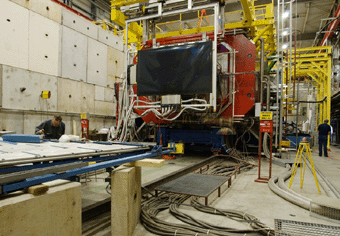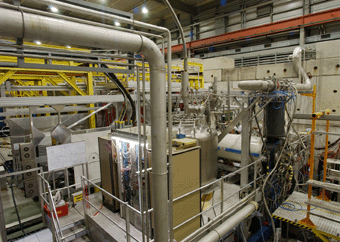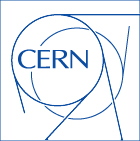The COMPASS
experiment in building 888 has started running, after several tests
made last year. It will basically investigate the structure and
spectroscopy of hadrons and is scheduled to run beyond the start of the
LHC. 
View of the COMPASS detector from behind in building 888 in Prévessin.
Finally its time has come! There has been frantic activity in building 888, the COMPASS
(Common Muon Proton Apparatus for Structure and Spectroscopy) kingdom.
Everything had to be ready for May 27, when the SPS started extracting
protons to feed the M2 beam line and the experiment began a full data
taking year for the first time. (Last year the first data were
collected after a long commissioning phase with an incomplete
spectrometer.) COMPASS will focus on learning more about hadrons -
particles made of quarks, including the nucleons (protons and neutrons)
of ordinary matter. It will try to find out how hadrons are built up
and in particular what contributes to the spin of the nucleon. A total
of 220 physicists coming mainly from France, Germany, Italy, Japan and
Russia are involved in this project, led by Franco Bradamante and
Stephan Paul. In 98 days of beam, they expect to obtain the first
results on the polarisation of gluons in the nucleon.
COMPASS is
60 metres long, 10 metres high and resembles an accordion with a
structure that is repeated twice. It is designed as a double forward
spectrometer, each section equipped with Ring Imaging Cherenkov (RICH)
detectors, electromagnetic and hadronic calorimeters and muon filters
for particle identification. Large spectrometer magnets and a variety
of tracking detectors determine the particle momenta. The first stage
of the installation is complete. The second stage, foreseen for the
future, will also include a second RICH detector and the final
electromagnetic calorimeter. 'We look forward to getting these pieces
in the future, so we can exploit the full physics programme of our
experiment. For the moment, we can already get interesting data for the
first part of the programme with the detectors we have', explains
Gerhard Mallot, technical coordinator for COMPASS.

The first part of the COMPASS detector, with the Polarized Target.
The
first section of the apparatus analyses particles with large angles,
while the second one focuses on smaller angle, faster particles. The
particles take the following journey. A beam pulse of 1013 protons, yielding a muon pulse of 2 x 108,
is taken by the beam line from the SPS to the polarised target, where
nucleons with their magnetic moments oriented at a temperature of 50 mK
are awaiting the collisions. Then the spectrometer tracks the emerging
particles before they arrive in the RICH detector. The RICH is a Ring
Imaging Cherenkov which identifies particles coming from the collisions
in the COMPASS target; in particular, it distinguishes pions and kaons
with momenta up to 60 GeV/c. Particles travel though the C4F10
gas contained in the RICH vessel with a speed faster than that of
light, causing the Cerenkov effect, a phenomenon analogous to the sound
of planes when they go through the sound barrier. It's a 'bang', but in
this case it's made of rings of light, which are focused by two
spherical mirrors - made up of 120 hexagonal and pentagonal reflecting
surfaces - onto two sets of detectors. These detectors are equipped
with caesium iodide photocathodes, a new technique developed at CERN in
the RD26 project, which converts the light into an electrical pulse.
Afterwards, hadrons deposit all their energy in the hadron calorimeter
and stop, so that only muons pass through, finally reaching the muon
detectors beyond the absorber wall.
There are a many features that
make COMPASS a unique experiment. It is the first time that such a big
experiment uses novel detector techniques, such as the Micro Mesh
Gaseous Structure (Micromegas), developed by Nobel Prize Winner Georges
Charpak, and the Gas Electron Multiplier (GEM) developed by Fabio Sauli
at CERN. The Micromegas cover the central part of the first
spectrometer, while the inner region of the second spectrometer is
equipped with GEM detectors. Both these gaseous detectors amplify the
electrons knocked out of a gas by charged particles as they pass
through. For the Micromegas this happens in a tiny gap of 0.1 mm
between a metallic mesh and the anode. The GEM, on the other hand, is a
thin sheet of plastic coated with metal on both sides and chemically
pierced by a regular array of holes a fraction of a millimetre across,
and apart, in which the amplification takes place. Large-area tracking
is provided by so-called straw detectors and high flux drift chambers
working with the same physical principle. Scintillating fibres and
scintillator hodoscopes provide highly precise time information and the
incoming beam is measured by silicon detectors.
The COMPASS
detector electronics remember the path of the particles and after 500
ns a decision is made on whether an interaction is interesting enough
to keep a record of it. Despite the careful selection of events, the
remaining data volume of 200 to 300 TByte/year will still be enormous;
the handling and analysis of such data volumes constitutes a real
technical challenge. However, the powerful COMPASS Computing Farm with
200 CPUs is up to this challenge and will help to reveal the interior
of matter.




